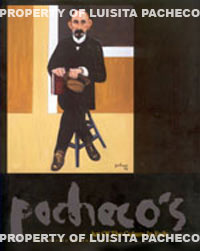
�"The Fight Doctor"

Pacheco�s
Art Of The Cubans in Exile
by Ferdie Pacheco M.D
�
�
Much
of Pacheco�s work possesses a strong narrative quality that brings to life
the experiences of the Cuban exile community. Those paintings which tell no
stories per se, are explained with colorful anecdotes, as in the Quince:
The Last Fitting (page 30) which includes essays on the customs of the �Quince� celebration in Cuban life.
��� Pacheco�s Art Of The Cubans In Exile is not a history of Cuban� emigration all over the world, rather it is a complication of his� firsthand�observations and reminiscences of Miami,� as seen from� the windows of his medical practice. With this book, Ferdie Pacheco� hopes to inspire other�Cuban writers, painters and filmmakers to� celebrate the lives of Cuban exiles in New York, Chicago, Tampa,�ersey City, Boston and elsewhere.
�